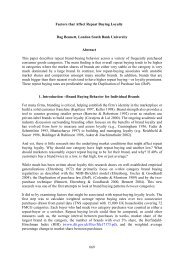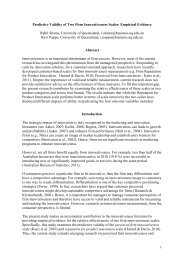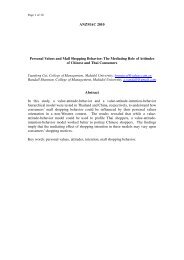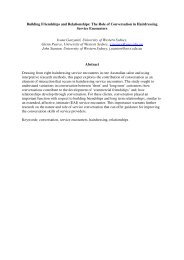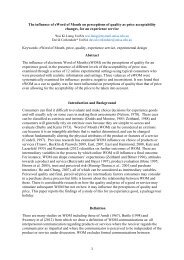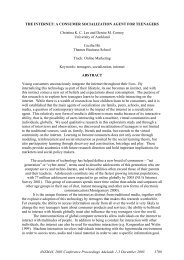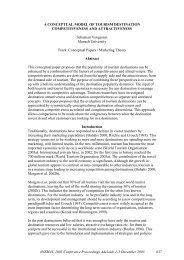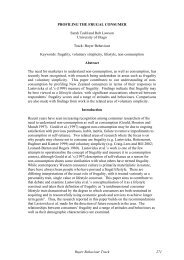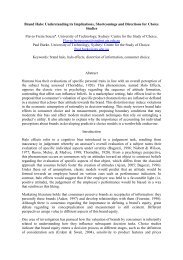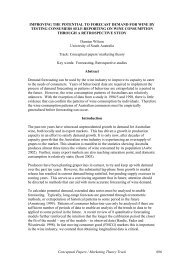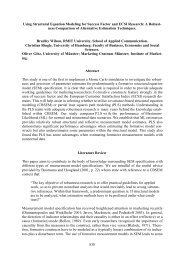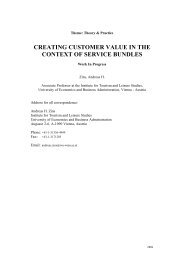amj Australasian Marketing Journal - ANZMAC
amj Australasian Marketing Journal - ANZMAC
amj Australasian Marketing Journal - ANZMAC
Create successful ePaper yourself
Turn your PDF publications into a flip-book with our unique Google optimized e-Paper software.
leather wallets and knit polo shirts (Wall et al., 1989); PCs and<br />
VCRs (Hong and Wyer, 1989); and blouses and dress shirts<br />
(Ettenson et al., 1988). For complex, infrequently purchased<br />
items, the origin country appears to have a significant impact<br />
on product evaluation in a multi-cue context (Han and<br />
Terpstra, 1988; Heslop et al., 1987, Iyer and Kalita, 1997),<br />
while that effect seems to be smaller for such items as wearing<br />
apparel (Ettenson et al., 1988; Heslop et al., 1987). Chao s<br />
(1989) study also demonstrates the importance of product and<br />
attribute specificity on the evaluation of products.<br />
3. The present study<br />
The study reported herein seeks to extend the existing<br />
research in the COO field by seeking to examine explicitly the<br />
differential effects of COA and COD in combination with<br />
other potentially important product cues, namely, brand and<br />
price. It also seeks to explore the impact of these product cues<br />
on two important dependent variables, namely, perceived<br />
product quality and expressed purchase intention.<br />
This study has been conducted on three types of products- car<br />
(as a high-involvement product), a pair of jeans (a mediuminvolvement<br />
product) and tinned pineapple (a low-involvement<br />
product). The present research examines the effects of<br />
COA and COD, individually and jointly, on the perceived<br />
quality of cars, jeans and tinned pineapple and on reported<br />
purchase intentions. In a previous study, Chao (1993) found<br />
that there was no significant interaction effect between COD<br />
and COA. He also reported significant price and COD main<br />
effects on the perception of design quality. Amongst the<br />
multi-cue studies published it has been commonly shown that<br />
the effect of country image declines when information about<br />
other product attributes is available to consumers. This result<br />
leads to the present objective, viz to extend the study of COO<br />
effects to take account of possible variations in the COD and<br />
COA and see how the Australian consumers use these cues,<br />
alongside other cues of brand and price in their judgment of<br />
the quality of products and their choice of products. It is<br />
expected that the presence of other factors such as brand and<br />
price will reduce the effect of COA and COD in determining<br />
the quality of a product. More specifically, it is anticipated the<br />
effects of both COA and COD would be less than the effects<br />
of other variables.<br />
Thus, the study reported herein seeks to examine explicitly<br />
the differential impact of a range of key variables, namely<br />
COA and COD; price; branding; across three product categories;<br />
in terms of both quality perceptions and purchase<br />
intentions.<br />
For this study, the following two hypotheses were tested, viz:<br />
H1:That COA, COD, brand and price are all significantly<br />
associated with perceived product quality, and<br />
H2:COA, COD, brand and price are all significantly associated<br />
with expressed purchase intentions.<br />
Country Design and Assembly<br />
4. Research design<br />
The study is exploratory in nature and based on a survey of<br />
consumers in Sydney, Australia. The methodology chosen in<br />
this study to estimate the impact of COA and COD, brand and<br />
price was conjoint analysis, as this technique seems ideally<br />
suited to the variety of multiple product attributes and potentially<br />
complex decision processes. In this study, the approach<br />
chosen was a full-profile conjoint analysis . The procedure is<br />
similar to that of an experimental design with repeated measures<br />
(Louviere, 1988). A set of product profiles (short product<br />
descriptions) was constructed by combining the attributes in a<br />
factorial manner generated by the SPSS Categories software.<br />
The subjects are asked to rate quality perceptions using a<br />
seven-point rating scale (extremely good/extremely poor),<br />
and purchase intentions in a five-point scale (definitely<br />
buy/definitely not buy). Hence the technique of direct evaluation<br />
of each profile was employed. This type of scale is typical<br />
for conjoint analysis tasks (Green and Tull, 1978).<br />
Table I displays the study design. Three product categories are<br />
considered: car, jeans, and tinned pineapples. These products<br />
were chosen as they were both representative of high-, medium-<br />
and low-involvement products and were also familiar<br />
products to the respondents. The attributes were chosen to satisfy<br />
the research objectives. In the case of the car, three brands<br />
with similar features were chosen, viz. Toyota Starlet, Ford<br />
Festiva and Hyundai Excel. For jeans, the three brands chosen<br />
were Levi s, Jag and Giordano. In the case of tinned pineapple 3 ,<br />
Del Monte, SPC, and Kara were the three brands. Three countries-of-assembly<br />
and three countries of design were chosen<br />
namely, Japan, Australia and South Korea for cars, the U.S.A.,<br />
Australia and South Korea for jeans; and Japan, Australia and<br />
the Philippines for pineapple Three price levels have been<br />
incorporated in the conjoint model: viz. the regular price of the<br />
product and two other price levels, respectively 20% less and<br />
20% more than the regular price. The price differential of +/-<br />
20% was applied in the expectation that it was greater than the<br />
just noticeable difference . At levels less than 20%, the danger<br />
was that the price differentials might not be a material consideration.<br />
All the brand names, countries-of-origin and countriesof-design<br />
and price levels were chosen according to the particular<br />
market conditions that prevailed in Australia at the time of<br />
designing the research.<br />
A set of product profiles was created by each possible combination<br />
of attributes, resulting in a 3x3x3x3 full factorial<br />
design with a total set of 81 profiles. In order to make the<br />
profile evaluation task easier for the respondents, a fractional<br />
factorial plan for three product categories was considered.<br />
The SPSS Categories software generated this fractional<br />
design 4 . Subjects, therefore, only had to evaluate nine profiles<br />
for the main effect and four for the hold out tests of validity<br />
of the model. The fractional design was constructed so that<br />
the interaction effects of interest could be estimated. The data<br />
collection process was executed in two phases, viz., a pilot<br />
<strong>Australasian</strong> <strong>Marketing</strong> <strong>Journal</strong> 9 (1), 2001 63



